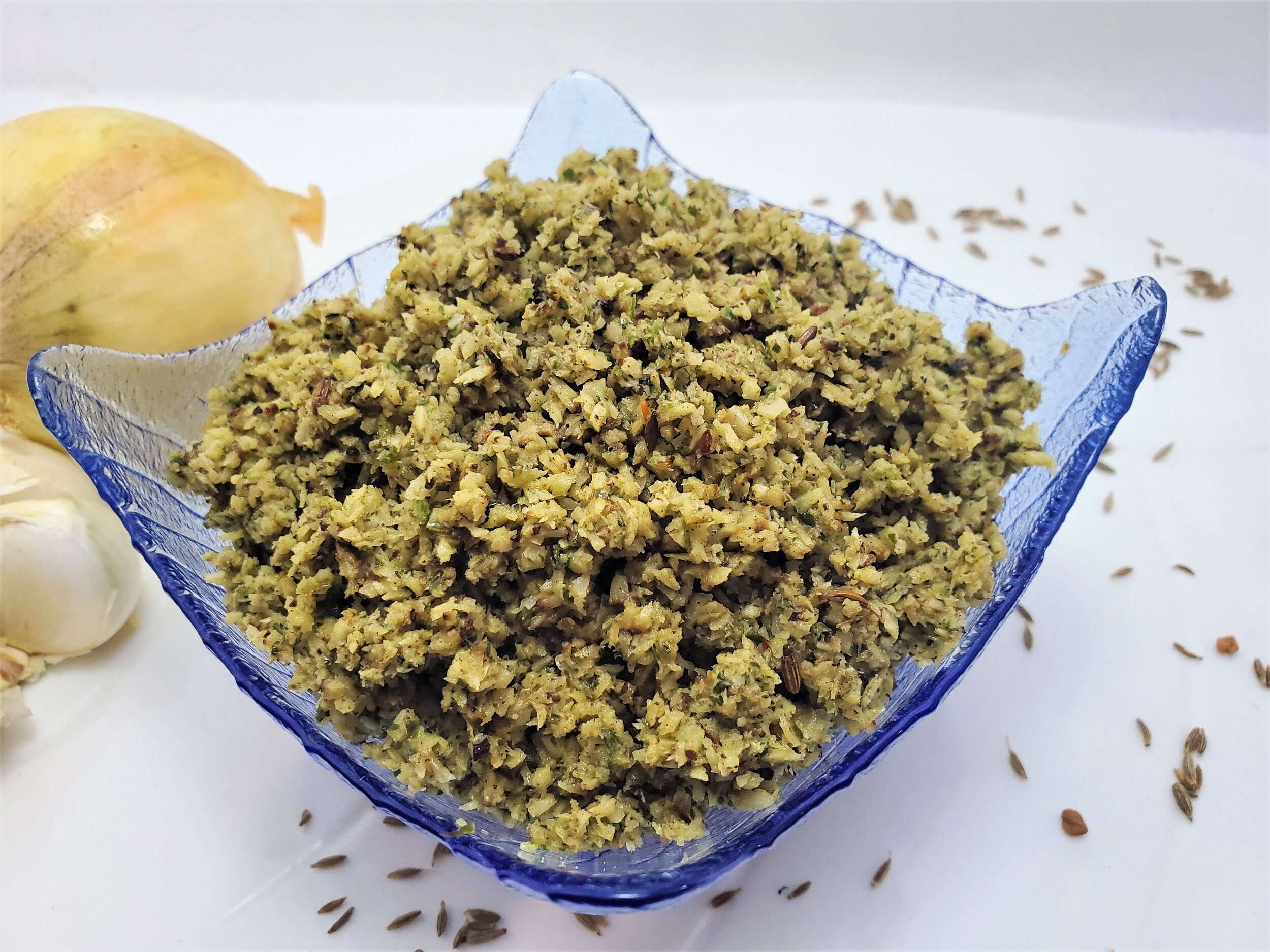My Mom's Trinidad Coconut Chutney
This recipe uses fresh dried coconut, which is combined with roasted peppers, garlic and onions. It INDISPUTABLY gives that delicious, smokey, coconut chutney flavour which takes you back to the days of your grandparents in the countryside of Trinidad.
My mom makes the BEST coconut chutney in my eyes. She roasts the dried coconut pieces on an open flame on the stove or chulha, together with garlic, pimentoes, hot peppers and onions. The traditional method involved grinding the coconut with a Lorha and Sil, before combining it with the other roasted ingredients and “chounkaying” the final mixture. The use of the lorha and sil method has now graduated to either grating or using a food processor due to technological advances, which gives you the same flavours but a slighly different texture. Here in Trinidad we have numerous types of chokas and chutneys, where the chokas are finished by the addition of hot oil, infused with garlic (and other aromatics if desired). This is one of the few chutneys that incorporates the same finishing technique which takes the flavours to a whole other level!
Everyone has their method of making this coconut chutney, so please feel free to adjust as needed. But DO NOT skip the roasting part. This is where the flavours develop that authentic smokiness that takes you back to the traditional countryside cooking. I usually serve this with kitchree (a traditional one pot rice dish made with rice, dhal or split peas and other spices), doubles, sada roti and anything else you want to put it on. It’s a great accompaniment to many different types of east indian dishes in particular.
Yield: About 1 1/2 cups of chutney
Ingredients
For the chutney:
1 small dry coconut
1 hot pepper- habanero/scotch bonnet/ and that is spicy.
2 medium pimentos
4 large garlic cloves- skin on
1/4 medium onion
8 leaves of bhandhania/culantro/chandon beni
1 teaspoon salt
To Chounkay:
1 tablespoon oil
1 teaspoon minced garlic
5 methee/fenugreek seeds (optional)
Method
Crack the coconut and remove the coconut flesh from the shell using a sharp paring knife (usually a short knife with a sturdy blade). Once removed, wash the pieces and place on the stove over a medium flame, to roast for about 5 minutes per side. Once roasted, allow to cool, and scrape all the black soot from the outside of the pieces. Wash the coconut and cut into 1 inch pieces. Place this in your food processor.
Roast the garlic with the skin on, onion, pimentos and hot/habanero pepper on the open medium flame, turning regularly. Peel the garlic and add to the food processor, together with the other roasted ingredients. Remember that you can add some or none of the habanero pepper if you prefer less spiciness.
Dried Coconut
Roast ingredients until you see those charred areas.
All ingredients are ready to combine. The garlic is done when it’s soft when squeezed or pressed.
Coarsely chop the bhandania and add to the food processor. Blend until the coconut is finely ground. Empty into a bowl, add the salt and set aside.
Add to the food processor and blend until fine.
Heat the oil in a metal Kalchul, or small saucepan. Add the methee and allow to darken in colour (do not let this get black!). Once it’s a deep gold colour, add the minced garlic, and allow to fry for a few minutes until it’s golden brown. I don’t like it too dark since it gives a bitter taste, but if you do, then, by all means, go ahead. Add this to the coconut mixture and mix thoroughly. Adjust salt if needed.
Learning Time
What is a Kalchul?
A kalchul is basically, a metal ladle. It is used to “chounkay” dhal or choka in Trinidadian cooking. Oil is heated in the kalchul over the direct burner flame on the stove, where aromatics such as whole geera (cumin), methee (fenugreek) and garlic and added to infuse the hot oil. When browned, it is then added to the dish which gives a rice, savory flavour to the dish.
In Trinidadian homes, we usually have 1 particular Kalchul which we use for everything.








